Brunfelsia: home care
Fragrant and beautiful flowers can decorate any house or apartment. One of these is Brunfelsia, which, in addition to external beauty, has its own characteristics. This plant of the Solanaceae family, which is quite rare for our latitudes, is able to decorate a room and bring aesthetic pleasure.
Botanical description of the plant
Brunfelsia, depending on the variety, is a bush or small tree of small size, but with an impressive crown. This plant does not require the reconstruction of the conditions of the tropics and can bloom at the end of winter, and some species bloom for a year. As the flowers develop, their hue changes from saturated violet to lilac or almost to white.

The appearance characteristics of this flower are summarized in the table:
| Characteristic | Indicator |
| Root system | Powerful, vast, wooding |
| Stem | Direct, branching, leafy |
| Leaf shape | Oval, oblong, up to 25 cm long |
| Leaf color | Olive green |
| Flower shape | Oblong tube with a five-leaf nimbus, 6 cm in diameter |
| Flower color | Saturated Violet to White |
| Fruit shape | Oval |
| Fruit color | Orange |
| Fruit flavor | The fruit is toxic |
Varieties
There are about 50 varieties of Brunfelsia. Not all of them have taken root in our latitudes, but some of them feel quite comfortable here.
Florists cultivate these types:
- americana (Brunfelsia americana) - a large bush up to 6 m high, light inflorescences of this brunfelsia have a pronounced aroma and large corolla tubules (up to 10 cm);

- low-flowered brunfelsia (Brunfelsia pauciflora) - a very ornamental bush (under natural conditions, the height reaches 3 m), blooming all year and covering flowers with all foliage;
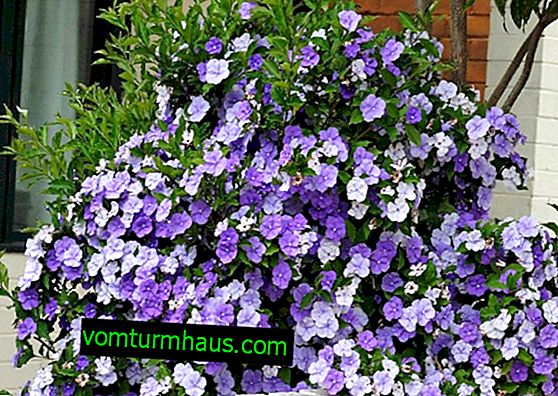
- large-flowered (Brunfelsia grandiflora) - a popular hybrid in large flowers in the form of a gramophone, blooms from early spring to mid-autumn;

- broadleaf (Brunfelsia latifolia) - a lush plant with large flowers and leaves that are kept on short legs, have a delicate aroma;
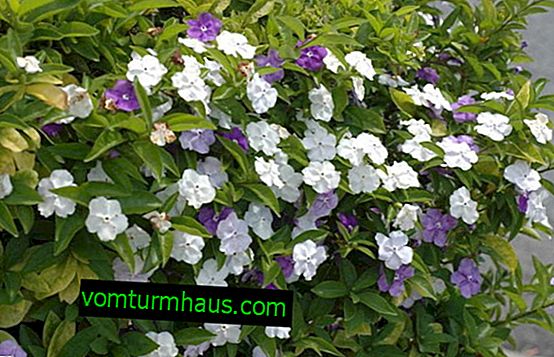
- Australian (Brunfelsia australis) - a small bush with very fragrant large flowers (up to 6 cm in diameter), used both in the form of a garden plant and indoor;
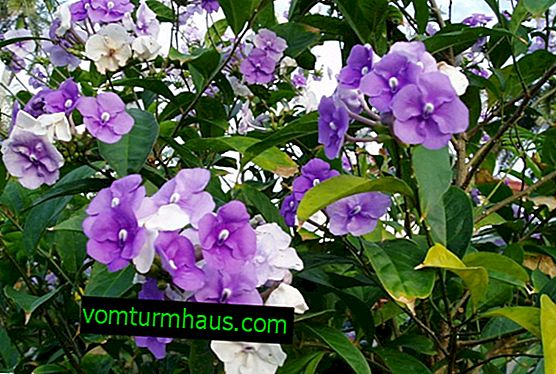
- magnifica - an average bush with large leaves (up to 30 cm in length), the color of inflorescences changes over time from bright purple to pale blue or white;
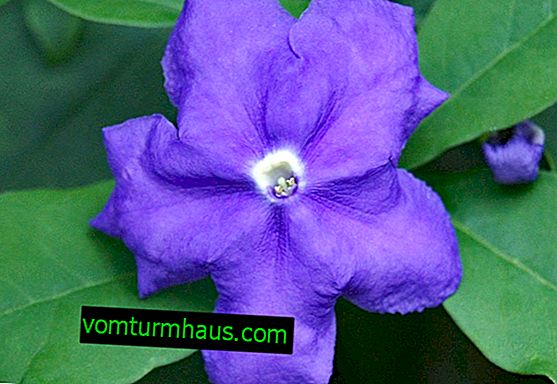
- Monaco is a medium bush with whole inflorescences exuding a wonderful aroma;
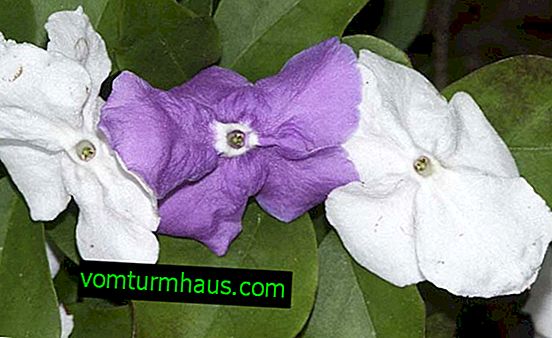
- Hopa (Brunfelsia hopeana) - shrub with dense large foliage and gradually growing brightening inflorescences, classic for this plant;
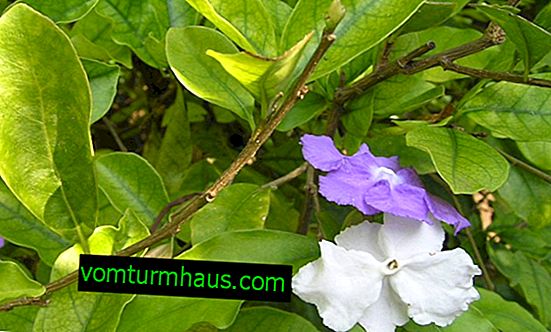
- calicyna var floribunda - bush with a stiff trunk, sprawling branches and large purple flowers;
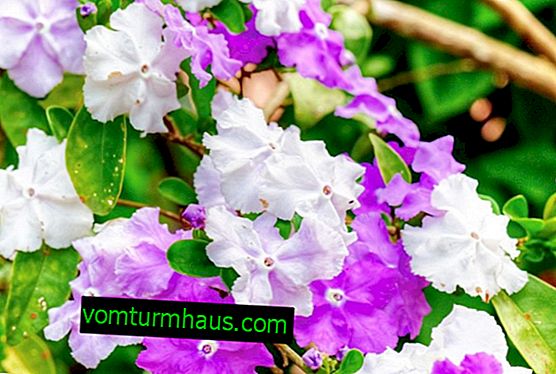
- uniflora (Brunfelsia uniflora) - a medium bush with single flowers that have a white tube and blue, gradually brightening, petals.

House growing conditions
Under suitable conditions and sufficient care, Brunfelsia feels good at home. It is enough to muffle direct sunlight, to provide the necessary humidity and temperature conditions in the room.
Did you know? Like some other plants in the nightshade family, brunfelsia, after some heat treatment, was used by shamans as a psychotropic.
Place for a flower
The flower needs a bright, but diffuse or slightly shaded lighting in the morning and evening hours. The east, southeast, or southwest sides of the house are well suited for this. Direct sunlight negatively and even destructively affects the plant, drying the leaves, so direct light should be avoided, creating an artificial shadow.

Temperature mode
In summer, a comfortable temperature for Brunfelsia should be + 23–25 ° C, although this plant is not too afraid of heat. But a decrease in temperature below +9 ° C at any time of the year can lead to its death. In winter, it is necessary to ensure that the temperature regime for two months is maintained at + 14-15 ° C - this will allow the plant to form buds for future flowering.
Important! Brunfelsia does not tolerate temperature extremes and can respond to cold drafts by dropping leaves.
Air humidity
It is quite difficult for a tropic inhabitant to live in an apartment, especially during the heating season, so you need to provide the flower with the necessary humidity. To do this, water containers are placed in the room, foliage and stems of the plant are sprayed daily. In large-leaved varieties, you can gently wipe the leaves with a damp soft cloth.

Home Care
Brunfelsia is a demanding plant, probably because our latitudes are not its natural habitat. Caring for it is a rather troublesome undertaking.
It is interesting to read about the royal begonia.
Watering
The need for frequent watering exists in the active phase of growth and during flowering. At this time, you need to water your green pets 2-3 times a week as the topsoil dries. In winter, when the plant is at rest, it is necessary to water less often - once a week, since the root system does not have time to absorb all the water and the process of decay can begin.

It is better to defend water for irrigation so that harmful impurities settle. You need to pour it with soft water at room temperature in small portions - then the liquid does not stagnate in the pot.
Top dressing
The abundant flowering of brunfelsia is achieved by the introduction of complex dressing. From mid-spring to mid-autumn at least once a week, you need to feed it with fertilizers for flowering plants. You can use universal liquid top dressing, diluting it in half with water. During winter dormancy, fertilizers are applied once a month.
Learn also how and how to feed indoor plants.
Pruning
Pruning is required to maintain the beautiful appearance of the plant. The process is carried out immediately after flowering before the onset of dormancy. All branches are cut to a third or half of the length with the formation of a crown of the correct shape, also the oldest shoots are removed. Thus, the growth of new branches is stimulated and the foundation is laid for the formation of buds for the next flowering season.

If the bush began to lose shape in the active time of growth and flowering, its shoots can be pinched at the top.
Transfer
To transplant the bush, wait for the end of the flowering phase and the onset of the dormant period. In this state, the flower will normally tolerate a change of scenery. A young bush can be replanted once a year, and an adult only after 2-3 years.
Important! The change of substrate or pot is carried out only when such a need arises, and not "for growth". No need to arrange the plant stress without excessive need. During the transplantation, it is necessary to provide a high-quality drainage layer and drain holes in the new “residence”.
The substrate is suitable acidic or slightly acidic. It is better to use the following types of mixtures in equal proportions:
- turf;
- sheet;
- coniferous;
- sandy.
Breeding
The plant can be propagated by seed and vegetative methods, as well as processes. The seed method leads to degeneration of the culture and the cultivation of wild game, as with similar breeding of other shrubs and trees. For normal development, a stronger wild bird should be inoculated with material from a normal plant.

Cuttings
For propagation by cuttings, it is necessary to select and cut off a stiffened branch with three internodes (no less), which is soaked for several days in a special stimulating solution. After this, the seedling can be planted in light soil "under the can" until rooting. The process takes 4-6 weeks, during which the sprout must be regularly ventilated and maintain the temperature under cover in the region of +25 ° С.
Scions
Adult plants can be planted by separating the same adult processes (the so-called separation of curtains). This method is more complicated, as the seedling is rather capricious and hardly takes root in the new conditions.
Did you know? Brunfelsia juice is not only a poison, but in small quantities can be a panacea. It can be a good painkiller, antiseptic and cleanser for internal organs.
Possible growing problems
This capricious plant does not feel well with a lack of attention. Pests can seriously ruin its appearance and even lead to death.
Disease
Diseases bypass Brunfelsia - it is immune to them. All problems arise only from poor care:
- violation of the conditions of rest - you need to normalize the amount and frequency of watering;
- improper lighting - avoid direct sunlight;
- the presence of drafts - the plant should be in a quiet place;
- irrigation conditions and air humidity - observe the irrigation regime and install water tanks near the pet.
Video: Everything you need to know about Brunfelsia
Pests
Pests can cause significant damage to the flower. The main pests are aphids, scale insects, insects and spider mites. In this case, the bush is treated with one of the insecticides in accordance with the instructions:
- Karbofos;
- "Decis";
- "Actellicus."
Brunfelsia can be called an exclusive plant that has adapted to the European climate. With careful care, it will delight for a long time with wonderful color and aroma.












